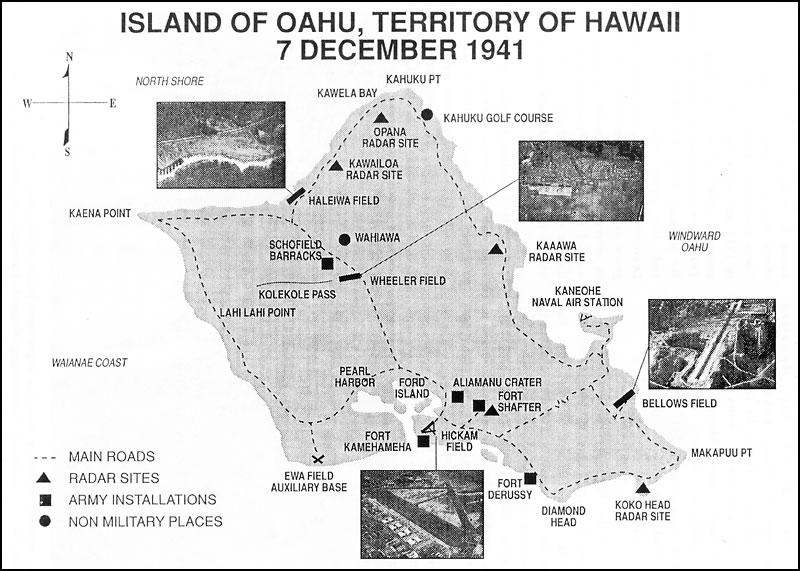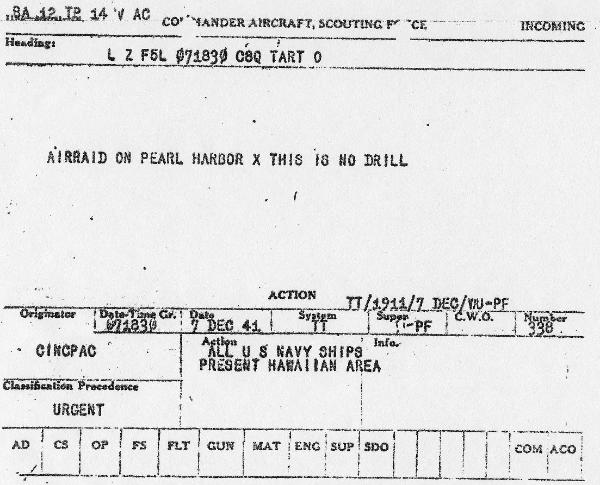US Navy Hawaiian area December 7, 1941 1100 Hours
Task Force 9 Picket force (all are at least 150-200 miles from Striking Force to northwest, west, or northeast)(submarines are making best speed to block the likely Japanese return heading either to the north or west)(surface ships are moving to last position of the Gamble)
Destroyer minelayers Gamble (sunk) , Ramsey, Montgomery, Pruitt, Tracy
submarines S-18, S-23, S-34, Gudgeon, Plunger, Tambor, Thresher
Scouting Force (Halsey)
Task Force 2 (Brown) carrier Lexington (w 37 Dauntless dive bombers, 18 Devastator torpedo bombers, 17 Buffalo fighters), heavy cruisers Chicago, Portland, Astoria, destroyers Porter, Drayton, Flusser, Lamson, Mahan, Cummings,
Task Force 4 (Fletcher) carrier Yorktown (36 Dauntless dive bombers, 18 Devastator torpedo bombers, 18 Wildcat fighters)heavy cruisers Minnapolis, Indianapolis, light cruisers Helena, Phoenix destroyers Farragut, Aylwin, Monaghan, Tucker, Ellet, Blach, Case (several of these ships meet up with the Yorktown just after dawn on December 8 after a high speed run from Pearl Harbor)
Task Force 3 (Halsey) carrier Enterprise (37 Dauntless dive bombers, 18 Vindicator Dive bombers,18 Devastator torpedo bombers, 14 Wildcat fighters), heavy cruisers Northampton, Chester, Salt Lake City, destroyers Maury, Craven, Gridley, McCall, Dunlap, Benham, Fanning,
Task Force 8 destroyer minesweepers Chandler, Hovey, Boggs, Lamberton, fleet oilers Platte, Tippacanoe, Santee, Sangamon
The Scouting Force is refueling 0730 hours – 1350 hours
Other Forces
French Frigate Shoals
Passing nearby: (returning from Midway) Seaplane Tender Wright (civilians aboard), Tranport Burrows (en route to Wake Island),
station: small seaplane tender Swan, Destroyer minelayer Sicard, patrol gunboat Sacramento
Kure: small seaplane tender Avocet, destroyer minelayer Breese,
(returns to Pearl Harbor afternoon December 7) California (3 bomb hits amidships, serious fires, secondary armament and fire control wrecked)
Task Force 1 (Anderson) (Midway Reinforcement Force)(returned to Pearl Harbor afternoon December 7, return to sea morning of December 9 after taking on personnel, cargo, stores and refueling)
battleships Maryland, West Virginia seaplane tenders Tangiers, Curtis, Hulbert stores ship Antares destroyers MacDonough, Phelps, Chew, Allen, Henley, Patterson, Ralph Talbot,
In port Pearl Harbor
110 Dock: battleships Oklahoma (sunk 8 torpedo hits, 2 in stern, part of stern missing, 5 amidships, 1 removed much of the bow, serious casualties, abandoned, on fire, serious oil fire covering much of this part of the harbor)
Fleet Target ship Utah (2 torpedo hits, sunk, abandoned)
submarine Cachelot (sunk by 1 torpedo, abandoned)(scrapped in place in 1942)
Drydock: battleship Pennyslvania (3 x 500 pound bomb hits, severe fire damage amidships wrecking 6 inch secondary 5 inch mounts), destroyers Cassin, Downes (both destroyers are constructive total losses due to multiple bomb hits, magazine explosions, fire damage)
Floating drydock: destroyer Shaw
Naval Station docks: heavy cruisers San Francisco (2 x 500 pound bomb hits, severe fire gutted hanger deck and aft superstructure, several 5 inch AA guns ruined), New Orleans (broken plates and some flooding from 2 x 500 pound bomb near misses, fantail, rudder, starboard screw need major repairs or replacement from 500 pound bomb hit) light cruisers St Louis (2 x 500 pound bomb hits, steering compartment wrecked, forward boiler room wrecked, severe fire damage amidships), Honolulu (2 x 500 pound bomb hits, B turret wrecked, 1 5 inch turret wrecked, forward 6 inch magazine flooded, fire damage amidships and forward superstructure),
destroyers Jarvis, Mugford, Bagley, Cummings, minesweeper Greebe, destroyer minesweeper Trever, Zane, Perry Wasmuth, destroyer minelayer Breese,
oiler Ramapo (severe fire damage from 1x 500 pound bomb hit),
repair ship Argonne, stores ship Rigel,
Southeast Loch (submarine base) docks: submarine tender Pelias, rescue ship Widgeon, repair ship Sumner, stores ship Castor, submarines Narwhal, Dolphin, Tautog,
Middle loch: repair ship Medusa, hospital ship Solace
Battleship Row
battleship Nevada (inboard)(2 torpedo hits, steering compartments, 2 boiler rooms flooded)(3 AP bomb hits, galley destroyed, 2 damage control teams wiped out, more damage to boilers, A turret penetrating hit and out of action)(fires are under control but has settled on the bottom),
destroyer Dobbin (outboard of Nevada)(serious flooding engineering spaces from concussion from Nevada torpedo hits)(1 AP bomb hit, detonated below the ship, keel broken, engineering spaces flooded)(sunk and being abandoned)
battleship Arizona (inboard)(1 torpedo hit, 3 AP bomb hits, forward magazine detonation, on fire, abandoned and sunk)
Repair ship Vestal (outboard) (1 torpedo hit, engineering spaces flooded)(flooded forward hold from Arizona torpedo hit, 1 damaging near miss and 2 AP hits that were duds, ship has sunk, severe fires from Arizona detonation, serious casualties from that and hits it has suffered, being abandoned)
battleship Tennessee (inboard)(D turret has lost a 14 inch gun to a AP dud, 1 AP hit has flooded the steering compartment)(fires from flaming debris from Hull and Arizona, being taken under tow by harbor tugs to move her from flaming oil from Arizona)
destroyer Hull (outboard) (destroyed by 1 torpedo hit which caused a detonation that broke her in two. Both halves are on fire and have sunk preventing magazine explosions. Severe casualties)
East Loch
destroyer tender: Whitney, minelayer Oglala, Destroyer Selfridge (fighting fire amidships from plane crash) oiler Neosho (three quarters of ship on fire, has been abandoned)
harbor entrance
destroyers Blue, Ward, Helm, Dewey, Worden, 4 minesweepers, 6 PT boats,
seaplane tender Thornton ( 2 torpedo hits from midget submarine, heavy casualties, beached off Hospital Point
Post attack fates of ships hit in the attack
Arizona broke in two as a result of the detonation of its magazine and can not be raised. Much of the steel above the deck level is taken off over the course of the war and recycled, while the guns end up assigned to the US Army Coast Defense branch. Her crew suffers the worst casualties numerically during the attack.
Oklahoma had an entire side of the vessel ripped open by 5 torpedo hits amidships and avoided rolling over only by heroic damage control work and ruthless counterflooding as well hits that followed that removed part of her stern and bow (essentially blowing the forward 20 feet of the bow completely apart) which opened up the starboard side to flooding (as did the removal of a substantial part of the stern). Basically enough water flooded in from the front and back of the ship, along with counterflooding, to allow her to sink with a severe list but not roll over. This rate of flooding was increased further by a torpedo that went into a hole created by a previous torpedo and blew out not only several compartments but vented the port side to flooding as well. Nearly 500 men die aboard her in flooded compartments or from the explosions of torpedoes. The second oldest battleship in the Pacific Fleet, and over 25 years old, she is considered a constructive total loss and not worth repairing. However she does take up valuable space at the 110 Dock, and so is refloated in a herculean effort in July 1942, and then towed out to sea and scuttled with honors. Over 100 bodies are discovered in compartments when she was pumped out and those men are buried with many of their crewmates at Honolulu National Cemetary. Her guns also end up with Army Coast Defense but are never used however some are used on other old battleships to replace damaged guns or guns worn out later.
Nevada is raised in May 1942, steams to Bremerton Naval Yard for repairs and modernization, and rejoins the fleet January 1943. Over 100 men were killed aboard her during the attack.
Pennsylvania is sent to Bremerton Naval Yard for repairs and modernization in January 1942, once the wreckage of the Cassin and Downes are removed and the dry dock is repaired sufficiently to return to service. Indeed the Dry Dock is the first priority of repair efforts. Two of the new Fletcher class destroyers get the names Cassin and Downes.
California is sent to Mare Island Naval Yard for repairs and modernization, rejoining the fleet in May 1942. Over 50 are killed during the attack off Oahu.
Tennessee is sent to Bremerton Naval Yard for repairs and modernization with the help of fleet tugs in late December 1941. She is then sent to Mare Island for further modernization and rejoins the Fleet in June 1942. Almost 200 were killed aboard her, mostly exposed personnel killed by the blasts and debris spread by the detonation of a destroyer alongside of her and a battleship directly astern of her.
The heavy cruiser San Francisco is sent to Mare Island in December 1941 and rejoins the fleet in February 1942 after modernization. Over 100 die aboard her during the attack.
The heavy cruiser New Orleans is towed to East Loch until the drydock is available again and then gets a new rudder and new screws and is sent to Bremerton for repairs and modernization. She rejoins the fleet in June 1942 and suffered 67 dead during the attack.
The light cruisers Honolulu and St Louis were high priority ships, as they are modern highly capable light cruisers. Both are given sufficient repairs at Pearl Harbor to send them to Bremerton in January 1942, and both rejoin the fleet in April 1942. Between them over 150 are killed.
The Vestal, Neosho, and Utah are all considered constructive total losses. The Vestal and Utah are raised, and along with the Neosho (which did not sink but simply was burned out) are towed out to sea and scuttled as not worth the risk of towing to the West Coast to be scrapped. Over 250 die aboard these three ships. The wreckage of the Hull, Thornton, and Dobbin are also raised, as the two destroyers are in valuable anchorages and the Thornton is too close to the channel for comfort, and they also are towed out to sea for scuttling. The Hull took the highest percentage casualties of the day, with only 14 of her crew of 160 man crew surviving the explosion of her magazine. Another 100 men died aboard the other two ships.
The Selfridge is quickly repaired and rejoins the fleet in February 1942 and suffered the loss of 23 dead during the attack.. The fleet oiler Ramapo rejoins the fleet soon after in March 1942, with 13 of her crew buried at Honolulu National Cemetary.
Other naval casualties from strafing, stray bombs and plane crashes number over 100.
Total Navy dead (including those killed on the Gamble) total 2357

